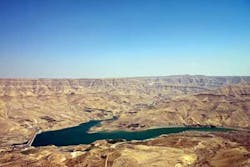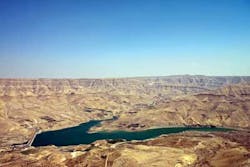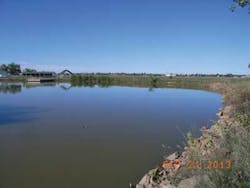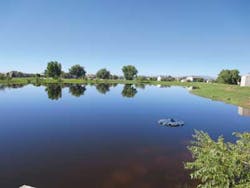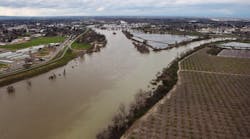By Rodney Eisenbraun and Laura LaRiviere
Nearly six months have passed since the devastating floods on Colorado's Front Range, allowing for a better perspective on the effects and lessons learned from this extraordinary rain event.
Overall, Colorado's emergency response and dam infrastructure management efforts were exceptional. Over 200 dams were inspected in 10 days by a team of engineers who volunteered their time and talents to ensure that the state's dams continued to meet stringent safety requirements after the event.
However, while all of Colorado's high-hazard dams withstood the floods, some of the low-hazard dams had breached - overflowing even more small ponds and contributing to the floods. The breaches were caused at least in part because the dams were subjected to inflow events larger than what they were originally designed for or required to pass.
Rocky Mountain High
The Front Range flood was instigated by a deadly combination of geography and meteorology. As cold air from the arctic and warm monsoonal air from the south converged in the central United States, the lethal storm slowly began dropping into Colorado's Rocky Mountains. What ensued shortly, and treacherously, was a week-long downpour in which more than 14 inches of rain fell on some areas of the Front Range.
As the unusually-heavy rain fell across the region, narrow canyons and steep topography funneled the water into the heavily-populated foothills to the west and north of Denver. The resulting flood affected nearly 4,500 square miles, killing eight and damaging or destroying as many as 2,000 homes. The floods also destroyed hundreds of miles of roads and left many small mountain towns completely isolated from neighboring communities.
If this storm were to happen in many other areas of the United States, or even the world, this event may have been much more disastrous. But the State of Colorado was prepared.
Colorado has a history of large storms. In 1965, rain-induced floods along the South Platte River basin swept through the Front Range and Eastern Plains, leaving 21 dead and 250,000 acres inundated and causing more than $540 million ($3.9 billion adjusted for inflation) in damage.
In response, Colorado's General Assembly created the Urban Drainage and Flood Control District, which was tasked with implementing an early warning system and helping municipalities within the district qualify for the National Flood Insurance Program. The group then began working with the U.S. Army Corps of Engineers (USACE) to institute new rules and requirements to ensure better defense from future disasters, including increasing the managed floodplain corridors and level of flood protection, and adoption of a flood control master plan.
The Federal government soon followed suit with the National Dam Safety Program (NDSP) in 1979. This program, under the Federal Emergency Management Agency (FEMA), was tasked with protecting citizens and property from the risks associated with the development, operation and maintenance of America's dams. During this time, a system of classifying dams was developed based on the risk the dam posed to downstream communities. Using this system, dams began to be classified as a high-, significant- or low-potential hazard based on the impact a failure event would have downstream.
Because of this legacy of flood control and awareness - and subsequent actions taken by the Federal government - Colorado was able to develop one of the nation's most stringent dam safety programs. That legacy continued to 2013, when the American Society of Civil Engineers (ASCE) rated Colorado as having one of the highest rates of Emergency Action Plans (EAPS) for high- and significant-hazard-potential dams in place in the nation: 97 percent.
EAPs are developed for use in the event of an emergency such as an impending dam failure or other uncontrolled releases of water. They provide significant information, which often includes detection and determination of the severity of an emergency, notification information and procedures, actions to take during an emergency, inundation limits in the event of a dam failure, and other dam-specific information.
Likewise, they are especially critical at high-hazard-potential dams that have the capability to cause loss of life in the event that they fail. And as dam safety is largely a state-by-state responsibility, having such a high percentage of EAPs is something to be proud of.
First-Person Response
Because of the state's legacy of dam inspection and preparation for emergency events, Colorado was able to coordinate and complete the largest dam inspection program in state history - inspecting over 200 dams in 10 days, mostly along the South Platte River and its tributaries. Over 100 engineers, including five from Kleinfelder, volunteered their time to inspect dams located in the hardest-hit communities.
Physical inspections began on Sunday, Sept. 22, just ten days after the storm began. At this time, the Colorado Division of Water Resources Dam Safety Branch gave our inspectors a list of 17 low-, significant- and high-hazard-potential dams to inspect over ten days.
Because of the size of the dams and the volume of water they stored, the majority of the dams we inspected were non-jurisdictional. Under current regulatory guidelines, these structures are not required to have EAPs in place. Because of these factors, our team had very little information before arriving on-site.
Once on-site, the team conducted inspections according to the most current methodologies. Dams were inspected for any seepage, voids, soil displacement, excessive vegetation, cracking, general erosion, and damage to the outlet works and spillway. Each team used a Dam Inspection Checklist, prepared by the Colorado Dam Safety Office. The checklist, combined with each inspector's knowledge of dam safety, allowed the site inspections to be completed quickly.
The results of the inspections were overwhelmingly positive. Of the 17 dams we inspected, one had overtopped but had not failed, two appeared to have been breached prior to the September event, and the remaining 14 had no problems containing the floodwaters. The results were similar across the state: throughout Colorado, all high-hazard-potential dams withstood the flood event. But nine low-hazard dams failed, and an unaccounted number of small ponds overflowed, ultimately contributing to the devastation.
Lessons Learned
While the initial actions by the state were quick and effective due to excellent organization and a wide range of resources, the Front Range Flood did highlight significant challenges regarding record keeping and hazard classification.
The majority of the structures we inspected were non-jurisdictional, meaning they did not have the same inspection and design requirements as jurisdictional dams. In these cases, the responsibility is placed on the owner to ensure the dam meets the requirements to protect human life and property over the structure's useful life. As such, many of these dams are not inspected on a regular basis or in some cases are not known by other authorities.
The issue of ensuring that the nation's dams are safe is challenging not only for Colorado but for many states. Of the 84,000 dams in the U.S., 53,760 are owned by a private entity, and 3,225 are owned by the federal government. Likewise, the vast majority of the non-federal dams rely on state dam safety programs.
Dam owners can solve this problem by regularly inspecting their dams and checking the accuracy of existing information. One of the challenges we encountered following the Colorado flood was determining the exact location of some of the dams.
This was due in part to location errors in the database. When the data was initially entered -sometimes over three decades ago - it was very difficult for owners to verify accuracy due to limited technology. New technologies such as Google Earth and geographic information systems (GIS) should be used to check the accuracy of existing location and design data. If owners discover inaccurate information, they should work with their local agencies to ensure that the information is updated so that responders can provide the best support during future crises.
Secondly, dam owners should make themselves aware of the possibility of reclassification and educate themselves on what may be required if their dam is reclassified to help prevent damage to property or loss of life.
A common misconception about high-hazard-potential dams is that they are in poor condition or do not meet current safety standards; this is simply not the case. It is possible, and frequently occurs, that a low-hazard-potential dam becomes a high-hazard-potential dam due to the construction of a residence or residences downstream.
For example, when dams were constructed near the city of Longmont (33 miles north-northwest of Denver), they primarily protected agriculture. In the ensuing years, the population of Longmont has grown to 86,270, making it the 13th most populous city in Colorado. Obviously, some of the dams in the area may no longer be qualified to be classified as low-hazard.
This challenge becomes more significant as we look at our nation's changing population densities. Fifty years ago, when approximately 70 percent of America's dams were built, many protected farmland and other low-population centers.
But as our population increases - estimated by the Pew Charitable Trusts to reach 439 million by 2050 - more people will be at risk. This growth will likely move development further into the unpopulated areas below aging dams, increasing the populations at risk and potentially reclassifying many low- or significant-hazard dams as high-hazard.
The Front Range flood taught us that preparing for another storm and mitigating potential impacts is the responsibility of the engineering community. Dam owners must prepare for the inevitability that a storm of this magnitude could happen again - and probably sooner than we expect.
